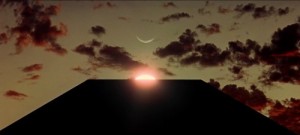Of course there has been a lot written about Kubrick’s “2001: A Space Odyssey“, a film that is in the top ten lists of many movie gurus, and therefore a genuine modern artefact. It is still worth making some comments about aspects that could be hidden below the surface. Or not. How do you see it?
Special Effects The film was released in 1968, and was in production for a long period before that. It is still considered to have probably the best depictions of space travel, due to the skills and inventiveness of Douglas Trumbull. This was in the days before computer generated effects were available, and ways had to be found of controlling camera movements and film processing to simulate aspects such as weightlessness and movement against a starry background with high scientific accuracy. Even in his later career (“Silent Running”, “Blade Runner” etc) Trumbull preferred to avoid computer effects. It’s worth looking at the saga involved in these achievements on 2001. (http://www.visual-memory.co.uk/sk/2001a/page3.html)
“The Sentinel” is a short story by Arthur C Clarke that was the starting point for “2001”. Explorers on the moon discover anomalous signals from underground. The premise is that a superior alien race has observed, three-or-so million years ago, that evolution on earth is leading to intelligent creatures. For their own possibly benign reasons they want to be kept informed when these earthlings achieve space travel. First stop will be the moon, so the sentinel, the high-tech monolith, is buried there waiting to be dug up by mankind, and then to send its signal to the aliens’ station on Saturn.
Kubrick and Clarke together expanded the story backwards and forwards in time, and both names are on the cover of the resulting novel “2001: A Space Odyssey”. But, as in every case of adapting stories to film, the book is one thing and the film another.
The book’s approach is as a straight science fiction story, where there is an internal logic that can explain everything that happens. Kubrick is deliberately not so literal – he leaves some puzzles, many things for the audience to interpret for themselves. The famous jump cut where the bone/tool thrown high in the air in triumph by Moonwatcher is instantly replaced by the Pan-Am space ship on its approach to the space station is a categorical shock. You have to say What just happened? Only by thinking about it do you connect it to three million years of technological expansion, which is considered to be step two in our development, and soon the next step will happen. We’ve gone from Animal – to Human – to What? The three note ascent in the “Also Sprach Zarathrusa” theme is a suggestion that the film’s journey is soon to enter the third level.
 As an example of possible metaphorical interpretation, the appearance of the monolith among the ape-men could suggest something more spiritual than concrete. The idea of human evolution is allowed to be accepted by followers of mainstream Western religion, but one problem involved here is that we humans are deemed to have an immortal soul, animals are not. Looking at a long line of evolving pre-humans, where is the point that the soul, created by God, was implanted? And was it suddenly switched on? Were there part-formed souls etc etc? The monolith’s arrival could be seen as a symbol of the demarcation between animal and human, or the work of the hand of God. I think Kubrick would have been happy for us to try out some such ideas.
As an example of possible metaphorical interpretation, the appearance of the monolith among the ape-men could suggest something more spiritual than concrete. The idea of human evolution is allowed to be accepted by followers of mainstream Western religion, but one problem involved here is that we humans are deemed to have an immortal soul, animals are not. Looking at a long line of evolving pre-humans, where is the point that the soul, created by God, was implanted? And was it suddenly switched on? Were there part-formed souls etc etc? The monolith’s arrival could be seen as a symbol of the demarcation between animal and human, or the work of the hand of God. I think Kubrick would have been happy for us to try out some such ideas.
A similar atmosphere of mystery surrounds the last section of the film when Bowman is apparently kept in a comfortable confinement – is he an exhibit in a zoo? A laboratory specimen? How long is he there? Fifty years? A million years? Time is not passing normally. What does it all mean? Where is evolution going to take us? You must make your own mind up – Kubrick is not going to do the thinking for us, but he does want us to think.
HAL The super computer with many human characteristics is a formidable figure in the film, especially when we can now appreciate that we are close to seeing the real thing in our lives. Eventually Hal causes havoc, with his stated intention of taking full control of the mission. For Clarke, in the novel, Hal has had a psychological breakdown due to an oversight in his programming, but Kubrick makes a strong suggestion that he becomes malevolent due to hubris – his infallibility has been questioned by the inferior earthlings. This is again open to interpretation.
However, Bowman’s ingenuity defeats Hal in a battle of wits and he disarms him. Is this expressing the hope that mankind can remain the overlord even when machines are vastly improved? Behind this there may also lurk the notion that by overcoming the machine Bowman (or Man) has passed a test – he then proceeds through the Stargate towards another level of existence, ending up as the Starchild with incredible potential.

